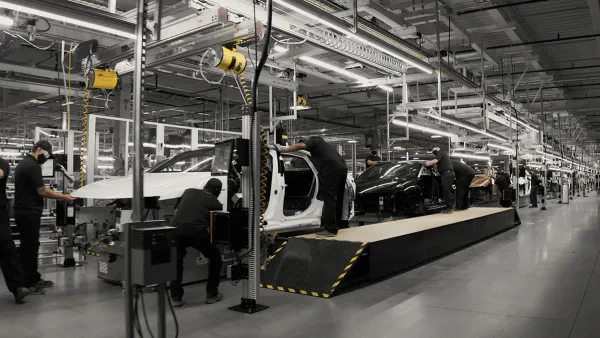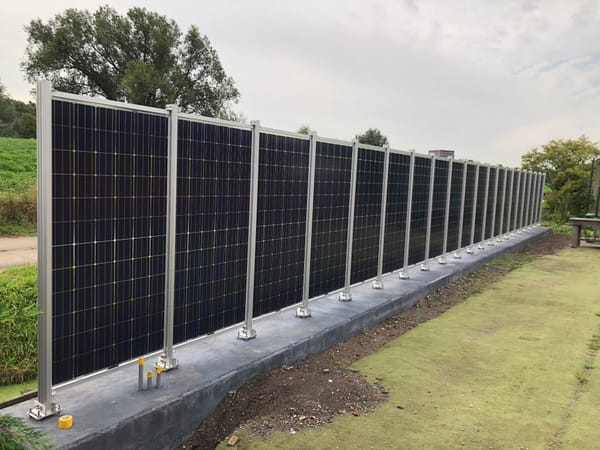California wants zero-emission trucks and trains, and solar panels are getting political
California, as it tends to do, is surging ahead of the country by banning sales of new diesel big rigs by 2036, by requiring all trucks to be zero emissions by 2042, and all new locomotives operating in the state to be zero emissions by 2035.
Chart of The Day

1. California’s big plans for zero-emission trucks & trains
California, as it tends to do, is surging ahead of the country by banning sales of new diesel big rigs by 2036, by requiring all trucks to be zero emissions by 2042, and all new locomotives operating in the state to be zero emissions by 2035. Diesel locomotives and trucks are the biggest source of fine particulates polluting the air in California, and nationally, trucks account for a quarter of all transportation-related carbon emissions. Still, there’s lots of questions about how affordable EV trucks will be, since most long-haulers are owned and operated by drivers. Also, battery-driven electric engines tend to have short ranges and long charging times, and most U.S. rails aren’t electrified like European ones are – and managing catenary wires in remote mountain areas subject to extreme weather is not exactly easy.
- California’s new truck rules require box trucks and delivery vehicles to be zero-emissions by 2035.
- A recent study shows battery-operated trucks are cheaper to operate over time, making them a better investment for smaller trucking companies.
- Maryland legislators recently passed a law requiring 15% of all commercial trucks sold in the state to be zero-emissions by 2027.
Sources: CalMatters / Canary
2. Solar panels, whazzup?
The cost of generating electricity from solar has been plummeting, as the manufacturing cost of photovoltaic panels has dropped by about 15% every year. Currently, about 80% of all solar panels are manufactured in China, while the U.S. is attempting to jumpstart a non-existing domestic PV industry with a 30% consumer tax credit for American made PV panels. Still, since there’s no existing industry for PV panels, solar installers have come to rely on Chinese-made products. Meanwhile, the American solar industry is in a big wait-and-see mode right now, as the U.S. Treasury is due to release rules on what qualifies as “American made” for PV panels, the GOP-controlled House passed a law to bring back Trump-era tariffs on Chinese solar panels, and that same GOP-controlled House tied eliminating solar panel tax credits to raising the debt ceiling.
- Solar panels last 30 years, that means millions of tons of panels will expire soon. The National Renewable Energy Laboratory says it costs about $15 to $45 to recycle a solar panel—or just $1 to send it to a landfill.
Sources: Reuters / Climate Home News / Anthropocene / Greenwire
3. The booming hydrogen industry in America
In some ways, the American government’s push to finance hydrogen fuel production seems to follow the Underpants Gnomes’ profit plan, but all kinds of respectable groups like the International Energy Agency say hydrogen fuel consumption will double by 2030, and only increase more after that. While there are hydrogen fuel cell cars, the most common uses would be for systems that require high, intense energy use, like airplanes, steel forges, and other industrial furnaces. The Inflation Reduction Act created tax credits for building large-scale hydrogen electrolyzers in the U.S., which is now surging ahead of Europe in the number of planned projects.
- Gaseous hydrogen is the smallest element, with just one electron, so it can easily slip through micro-fractures in storage and piping, a problem that hasn’t been fully solved.
- Around 269 gigawatts of hydrogen electrolyzer projects will be online by 2030, compared with around 0.45 gigawatts today.
Sources: WSJ / Washington Post
4. Green tech finance is stumbling in developing country countries
While the United States has plenty of capital to finance the green energy transition, underdeveloped countries do not, tend to be highly reliant on coal and other fossil fuels for energy, and also tend to be in environmentally sensitive areas that are already getting pummeled by climate change-driven disasters. To fix that, rich countries have made a number of pledges to finance improvements, like a 2009 pledge to provide $100 billion to finance the green transition and a pledge (with no dollar amount) at last year’s COP27 climate talks to finance climate-driven “damage and loss” in poor countries. The trouble is, rich countries, especially the United States, aren’t stepping up to fund the pledges, and it turns out the cost of green transition projects will be much bigger than expected. Either way, at some point rich countries will have to pony up, because without funding, poor countries won’t decrease their carbon emissions, and global climate will continue to worsen.
- South Africa has a $8.5 green transition project from coal, but it’s beset by corruption.
- Vietnam is planning to ask for loans to support a $15.5 billion program and Indonesia is preparing to ask for $20 billion to help transition to green energy.
- The World Bank has been charged with not doing enough to support these projects, last week it announced a $150 million program for Panama for green tech and to protect mangrove forests.
Sources: Climate Home News / Bloomberg / Climatewire
Other Things Happened
This week’s New Yorker magazine is dedicated to a number of “big think” climate problems and solutions. The Sierra Club is laying off some staff and restructuring to focus on GOP-dominated states. The first new nuclear reactor in 7 years – one of 93 in the country – is entering a test phase. “Pumped storage”, basically moving water up a hill with renewable or cheap electricity, then down a hill through turbines when power is needed, is having a moment, especially in China. A deep dive into the impact of the ravenous demand for EV-related bauxite on Guinea in West Africa.





